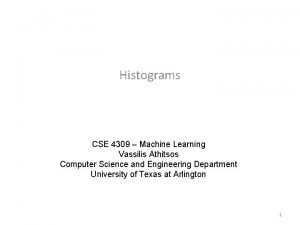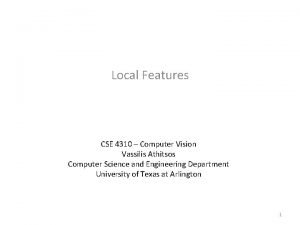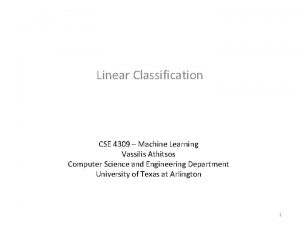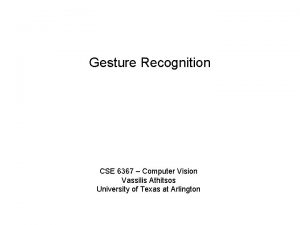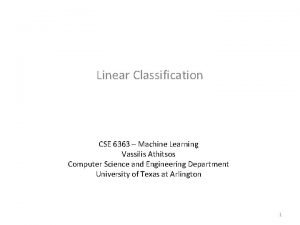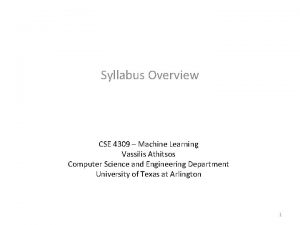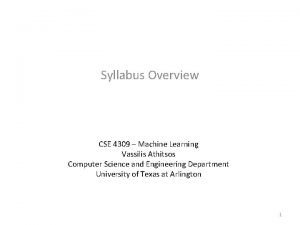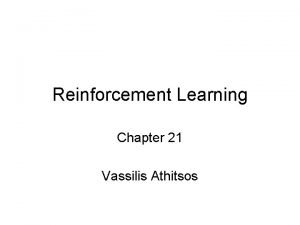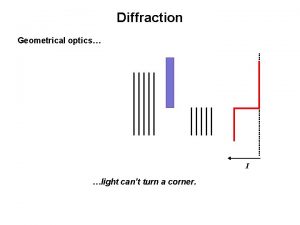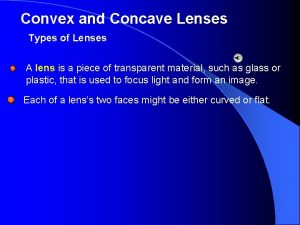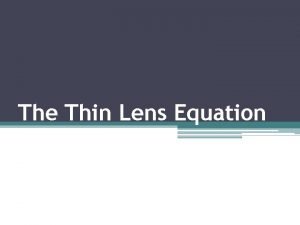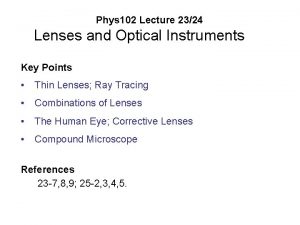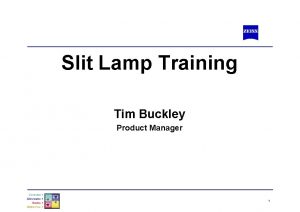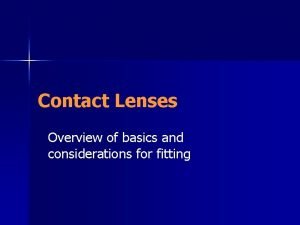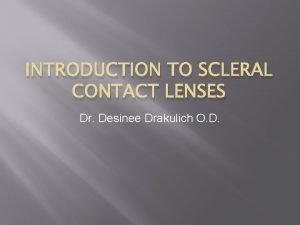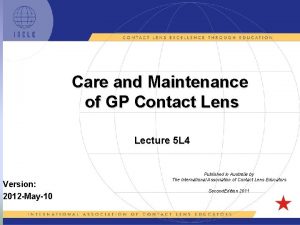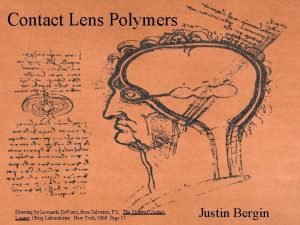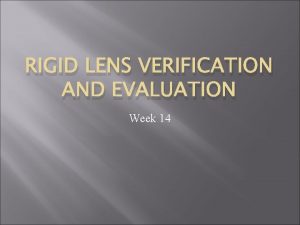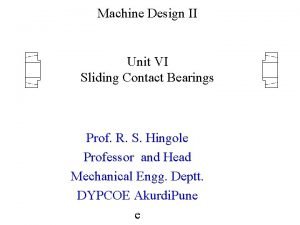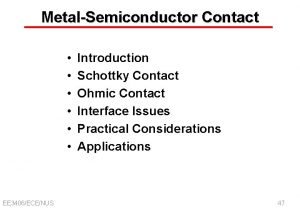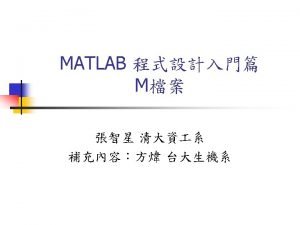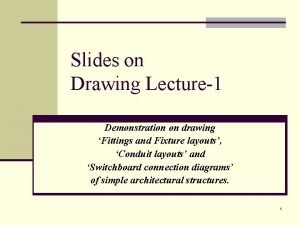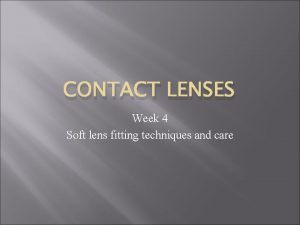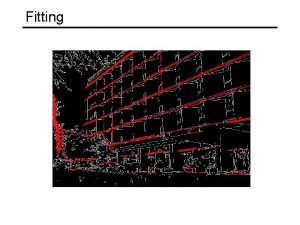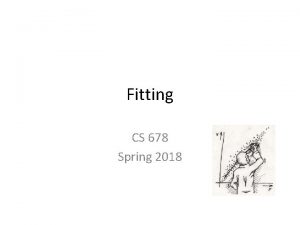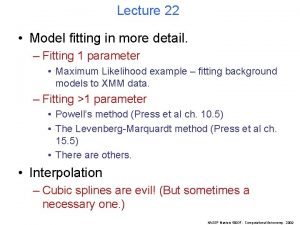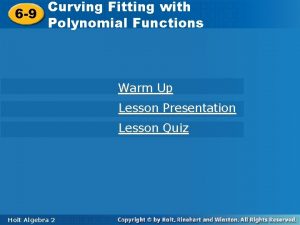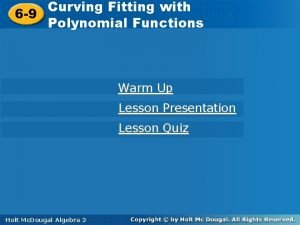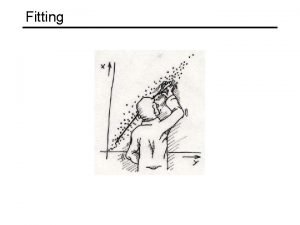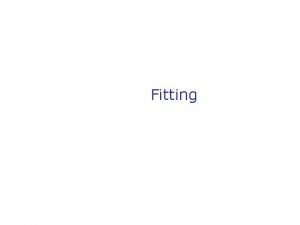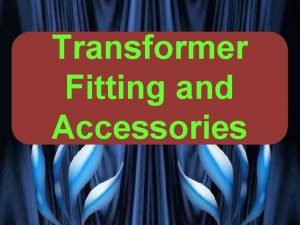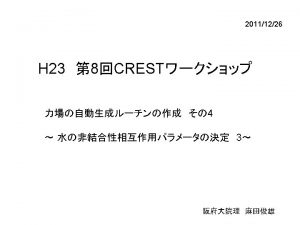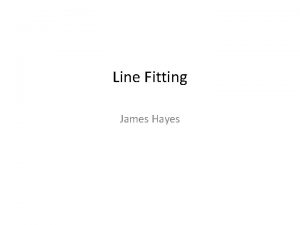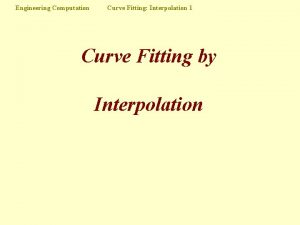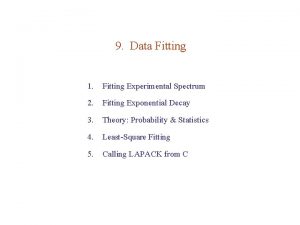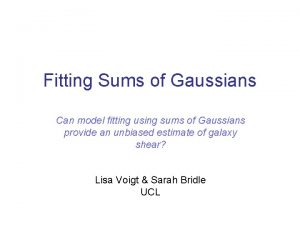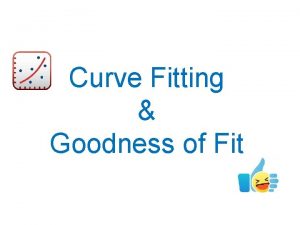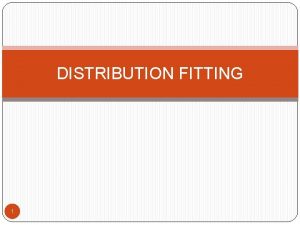POSTSURGERY CONTACT LENS FITTING Vassilis Fotinakis M Sc




































- Slides: 36

POST-SURGERY CONTACT LENS FITTING Vassilis Fotinakis, M. Sc.

POST-SURGERY CONTACT LENS FITTING • Post – Refractive Surgery • Post Corneal Transplant • Post corneal cross-linking

POST REFRACTIVE SURGERY • POST RADIAL KERATOTOMY • POST PRK ( Myopic / Hyperopic ) • POST LASIK (Myopic / Hyperopic ) Generally dealing with: 1. Post surgery remaining refractive errors 2. Iatrogenic ectasias and keratoconus 3. Decentered optical zones, elevated incisional scars, etc…

RADIAL KERATOTOMY (RK) • Radial keratotomy (RK) is a refractive surgical procedure to correct myopia, developed in 1974 by Svyatoslav Fyodorov. In RK, incisions are made with a diamond knife. Incisions that penetrate the corneal stroma in a depth of up to 90% of the corneal thickness

POST RK TOPOGRAPHY

PRK • A corneal tissue subtraction/ablation technique in which an excimer laser is used to remove tissue to alter the shape of the cornea. The high energy UV light (193 nm) is delivered to the cornea through a pulsating spot or slit

LASIK • The most popular laser surgery technique in which a corneal flap is created either by a mechanical microkeratome or a femtosecond laser one, the flap is folded back revealing the clear stroma on which the excimer laser acts and subtracts corneal tissue.

POST LASER SURGERY CHANGES IN CORNEAL TOPOGRAPHY • Main feature of corneal topography after PRK/LASIK is a markedly flattened central corneal area of 6 -8 mm.

POST LASER SURGERY CHANGES IN CORNEAL TOPOGRAPHY

POST RK CONTACT LENSES Post RK cornea challenges • Central versus mid peripheral cornea • Irregular astigmatism • Elevation of incisional scars • Fluctuating refractive error • Corneal neovascularization • Post operative glare and photophobia

Post Refractive Surgery CL Fitting • RGP(High Dk/l, large diameter usually , tint for glare and UV protection) – also Piggy Back • SOFT (SPHERIC OR TORIC) • HYBRID • SCLERALS

Post Refractive Surgery CL Fitting • CL fitting should be delayed for 3 to 6 months • BOZR should be selected following either a) Computerized corneal mapping b) Peripheral keratometry c) Preoperative keratometric readings

Post Refractive Surgery CL Fitting • • • Very flat central area Loss of steep apex to aid centration Large diameter for stability Large BOZD to avoid flare Fit to “normal periphery” Cases of corneal ectasia or decentered ablations are most challenging

Post Refractive Surgery CL Fitting • BOZR is suggested to approximately equal the corneal curvature 4. 00 mm temporal to the centre of the cornea (can be estimated with corneal topography and/or a modified keratometer peripheral reading) • For example if central K readings are 8, 80 along 180 and 850 along 90 and reading at 4. 00 mm temporally is 7. 85 then the first selected BOZR should be 7. 85

Post Refractive Surgery CL Fitting • The cornea usually flattens by about 0, 1 mm from centre to mid-periphery. After RK flatenning slightly increases and mid peripheral readings should be about 0, 2 mm flatter than the preoperative central corneal readings. (e. g. for pre-op central K reading 770 x 180/7, 50 x 90, mid peripheral readings should be 7, 90 post-op and this should be the first selected BOZR). • Alternatively, if the other eye has not been operated add 0. 20 mm to the central K readings of that eye.

THE DIAMETER ISSUE: SIZE MATTERS ! • In general, after refractive surgery the difference – sometimes marked – between the central treated part and the mid periphery and far corneal periphery makes CL fitting rather challenging. It is difficult with simple designs to have a fair alignment in both central and peripheral cornea, especially for significant refractive corrections. Thus, in RK/ PRK/LASIK, in the case of RGP lenses, large lens diameters and large BOZDs are preferred as the yield much more stable lenses and vision. • Aspherics also seem to perform better as they distribute lens mass more evenly across the cornea and they deal slightly better with spherical aberrations.

SLIT LAMP and other stories…. • Fluorescein assessment is important but never expect a textbook pattern • Usually there will be some central pooling and mid peripheral bearing • Go for maximum comfort and best optical correction. Usually what gives best comfort and acuity might be the best regardless of fluorescein pattern • Expect re-fitting possibilities and be ready to manage any mild complications • You can always opt for topography-based lens design. Technology can now deliver. • Use High DK/t materials that also feature satisfactory rigidity in order to avoid lens flexure

POST Refractive Surgery RGP lenses

POST Refractive Surgery RGP lenses • http: //www. youtube. com/watch? v=HPZn_1 T 6 js&feature=autoplay&list=UUAb. ZXC 3 J 0 h. FVs. Rk. DYGhm Xi. Q&playnext=1 • http: //www. youtube. com/watch? v=pp. T 3 a. ZFw. Lb. M&feat ure=relmfu • http: //www. youtube. com/watch? v=6 vfis 1 LXVBc&featur e=relmfu o e d i v e c Ni m o r f s n o i t a t n e s e r p n w o s i h n o e s o R Paul s e s n e l n desig

OTHER RGP ALTERNATIVES • Large diameter semi-scleral rigid lenses – Best centration and stability - Diameters 13, 5 -16, 00 mm – High Dk materials – Need to have a proper diagnostic set. • Reverse Geometry RGP lenses – Especially for high refractive corrections they might provide the best alternative. Post surgery cornea is oblate rather than prolate and RG lenses with central radius flatter than the peripheral one have a theoretical advantage. Fitting based on topography and mid peripheral radii. Go for a fit that exhibits some apical clearance and mid peripheral alignment. Computer programs integrated in modern topography instruments can help a lot.

POST – LASIK ECTASIA Iatrogenic keratoconus and has to be treated like that. Several RGP designs, soft customized lenses and hybrids can be applied… I would personally opt for the latter two options

LASIK FOR HYPEROPIA • Excessive removal of tissue can lead to central corneal bulge • “Pseudo keratoconus” • Pigment ring around cone • Can have very steep central K’s • Aim to flatten central ”cone” • Fit using keratoconic fitting set

POST Refractive Surgery SOFT LENSES • CUSTOMIZED SOFT LENSES FOR THE IRREGULAR CORNEA • Kerasoft IC is the most known example but there also other manufacturers • • • (e. g. Eyeart, etc…) Can be designed and manufactured with the aid of topography images Fully Tailor-made Periphery is configurable to suit the individual eye Sector Management to fit even the most complex corneal distortions Optional reverse geometry on steep peripheral fits Tailor-made to meet the needs of the individual eye Easy to handle 74% water content Silicone Hydrogel material for increased oxygen permeability and comfort Also available in high water content Hydrogel for annual replacement options Some of them feature Wavefront optics to provide enhanced visual acuity Simple Fitting System-Fitting sets Wide Range of Parameters (also toric, multifocal…)

POST Refractive Surgery SOFT LENSES Pros and Cons Pros : Satisfactory Oxygen performance Fully tailor-made Wide range of parameters Producing less or no scarring and can act also as bandage lens • Provides protection from foreign bodies and wind, good for exterior recreational activities, sports, etc. • Very hard to fall out of the eye or be misplaced • •

POST Refractive Surgery SOFT LENSES Pros and Cons : • As they lack a rigid surface, in most cases they will not yield maximum visual acuity • Tend to impinge on the scleral conjuctiva, yielding a “sucking” effect • Sometimes can be hard to extract from the eye • More prone to allergic conjuctivitis and infections due to their soft material. Maybe best to use with peroxide systems.

HYBRID LENSES • RGP center and Soft peripheral “skirt”. • First it was Saturn, then Softperm, now Synergeyes or Eyeart family of lenses • The RGP centre is now very highly permeable while the soft periphery has recently been upgraded to Si. H in a certain lens (Duette – officialy designed just for astigmatism correction)

HYBRID LENSES Always u se trial se ts – exam fluoresce in pattern s closely leave 30 minutes f o rs refraction. With ne afe overw High D materials k they seem a very interestin g alterna tive to RG Ps with e u s s i n t be a h g i m and e r u The s s e r ral p e h p quent i r e f p o s , mid s ange h c es y m h i t p e a r m g o o S top ust. m a s i mall s g n n i i r t o r t i e n x mo and e t r e s n i ere h o t T t. l o u o c i t f dif nsive e p x e r e h dling n a h l a eyes, rat e out id b a s o e d are vi ube T u o Y n i even

HYBRID LENSES Clearkone Synergeyes lens, ideal fit Fitting profile at the slit lamp of a Hybrid lens

PIGGY BACK LENSES Use High Dk materials for both soft carrier lens and RGP lens. Frequently low minus or low plus powers are indicated for the soft lenses, yielding more normalized curvatures for the RGP lens to sit on. However, it may be possible to use a stronger minus power and decrease the residual RGP lens power and have a thinner lens and a larger BOZD as a result…. SO DON’T BE AFRAID TO EXPERIMENT

CORNEAL TRANSPLANT 1. PENETR ATING KER ATOPLAST 2. LAMEL Y LAR (OR D EEP LAMEL LAR KERAT OPLASTY) MAIN REA SONS: A) K ERA KERATOPA THY, CORN TOCONUS, PMD, BU L EAL DYSTR etc…. . OPHIES AN LOUS D SCARRIN G, TIME OF F IT : 8 -20 M ONTHS PO THERE IS U ST S RGENT NE ED FOR VIS URGERY, UNLESS ION

CORNEAL TRANSPLANTS AND CONTACT LENSES 1. Post Surgery residual ametropia and usually high, and not always very regular astigmatism 2. Eccentric grafts, tilted grafts 3. Central region stands proud of the host tissue 4. Commonly found plateaus, islands and other geographical features…. .

POST CORNEAL GRAFT LENSES • RGPs usually large diameter ones (Reverse geometries sometimes ) • Hybrid lenses and piggy back systems, mainly the former • Sclerals and mini sclerals • Soft customized lenses, frequently featuring reverse geometries

POST CORNEAL GRAFT LENSES Large diameter RGP lens SYNERGEYES PS LENS OVER TRANSPLANTED CORNEA Synergeyes PS Hybrid lens

POST CORNEAL GRAFT LENSES

POST CROSS-LINKING FITTING – DOES IT REALLY MATTER ? • Central and paracentral/midperipheral curvatures may change • Previous RGP pair does not fit well – especially if it is a small diameter one. • New optical prescription • Frequently surgeons ask for refitting into soft lenses as they are more afraid of scarring – particularly if there has also been an additional laser treatment which is allegedly related to stromal haze after the procedure (e. g. Athens Protocol ? )

Thank you all for your attention Questions will be answered at the beach with a well chilled cocktail in hand
 Vassilis athitsos
Vassilis athitsos Vassilis athitsos
Vassilis athitsos Vassilis athitsos
Vassilis athitsos Vassilis athitsos
Vassilis athitsos Vassilis athitsos
Vassilis athitsos Athitsos
Athitsos Vassilis athitsos
Vassilis athitsos Awareio
Awareio Passive reinforcement learning
Passive reinforcement learning Fresnel and fraunhofer difference
Fresnel and fraunhofer difference Covex and concave
Covex and concave Linear magnification
Linear magnification Converging vs diverging lens
Converging vs diverging lens Advantages of contact lenses
Advantages of contact lenses Sam fap contact lens
Sam fap contact lens Slit lamp training
Slit lamp training Truncation contact lens
Truncation contact lens Jupiter scleral lens
Jupiter scleral lens Menicare gp cds
Menicare gp cds Leonardo da vinci contact lens
Leonardo da vinci contact lens Jelly bumps
Jelly bumps Bionic contact lens university of washington
Bionic contact lens university of washington Contact lens
Contact lens Verifyleins
Verifyleins Noncontact force examples
Noncontact force examples Irritant vs contact dermatitis
Irritant vs contact dermatitis Post encounter stage
Post encounter stage Machine design
Machine design Air resistance contact or non contact
Air resistance contact or non contact Contact forces
Contact forces Non contact force definition
Non contact force definition Contact and non contact forces
Contact and non contact forces Contact and noncontact forces
Contact and noncontact forces Dangling bond
Dangling bond Loose-fitting clothing
Loose-fitting clothing Matlab
Matlab Fitting and fixture layout
Fitting and fixture layout
